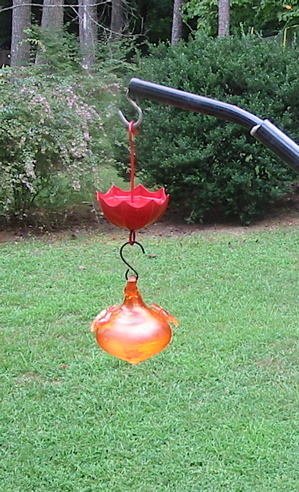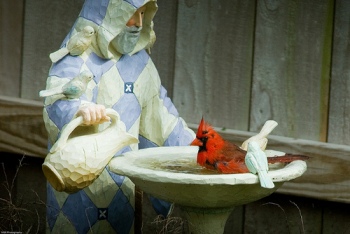-
keep ant moat water from evaporating
With the big migration underway, it’s a hectic and busy time of year for hummingbirds! It’s not the temperatures, but rather the number of daylight hours which dictate migration. This natural occurrence, along with instinct tells the tiny sprites it’s time!
For their long journey back to Central and South America, hummingbirds will need lots of energy, and feeders are a critical source for that food. Due to extreme summer weather conditions around most of the country, many hummingbirds have become accustomed and/or dependent on them. Be sure nectar is always fresh and sans the ants!
If the water in your ant moat seems to evaporate quicker than you are filling feeders, this little trick will help slow the process. Cooking oil. Yes; corn, olive, peanut, any kid of cooking oil added to the water will greatly help slow evaporation. Just a drop or two will do it, and you’ll always be covered in the pesky ant department!
- Bird Houses, Copper Roof Birdhouse, Decorative Bird Houses, Uncategorized, Unique Birdhouses, Vinyl with Copper Roof Birdhouses
fine copper roof birdhouse with options-a-plenty!
A bevvy of great options come with these fine bird homes, including shape, number of entrances, portals or perches at the entrance, and your choice of roof finish.
But the very best part is the vinyl/PVC construction which makes for superb quality that lasts a lifetime! You’ll find a copper roof birdhouse in square, hexagon, or octagon shapes, ranging in size from small, medium and large, to the jumbo estate size. The number of entrances depends on which birds you’d like to attract, using a single entrance for bluebirds, with eight-or 12-entrance model for martins. Of course house placement and habitat will also determine who may take up residence.
Some folks want them for the aesthetic alone, and on occasion they want to know how to keep the birds out? 🙁
The roof is available in a patina finish (shown above) or bright copper. The latter will actually stay “bright & shiny” for about fours years, at which time a coat of polish may be applied should that brand new look be desired. The copper is treated with a
lacquer to keep it from weathering. Also available with no lacquer, it will turn quicker. This is appealing to some who may have an older or restored home with copper accents. If the roof is left to weather naturally, it’s more likely to match the residences’ copper accents for a more cohesive setting.
Even the finials will not rot, they’re a composite resin and promise to remain just as new as day one. Complete with the decorative brackets (also in vinyl), the birdhouses fit right on a 4×4 post. The base includes a collar, or recessed sleeve (where the brackets are attached) that allows for easy installation. All roofs lift off (no screws) for simple nest removal. A copper roof birdhouse like this will grace any landscape with a simple elegance for many years to come!
-
The hottest july ever?
Sources all over have been telling us this past July was the hottest month on record… ever! As if we don’t know that; by the brown lawns, dying summer flowers, and shriveling leaves. Here’s an interesting article from AUDUBON WINGSPAN: ATLANTIC FLYWAY EDITION on how birds beat the heat.
A cardinal cools off in a birdbath. Photo: Michael Glasgow / CC BY-ND As temperatures bake much of the United States and the nationwide drought continues, crops wither and fish die. But they aren’t the only ones suffering from the blazing summer. Birds are also trying to keep their cool. But they don’t sweat like humans, or even pant like dogs; instead, they have a variety of unique adaptations to help beat the heat.
In a study conducted on marsh sparrows in 2011, scientists found that bill size correlates to outside temperatures. Marsh sparrows with larger bills live in warmer climates, for example. The study noted that the tropical toucan also possesses a large bill, and has the ability to increase or decrease blood flow to its beak to either promote or prevent heat loss.
Laura Erickson of the Cornell Lab of Ornithology, however, points out that the size of a bird’s bill isn’t the only factor that keeps it cool.
“In the case of the raven, the further north you go the bigger their bills are,” says Erickson. “But they need the bigger bill to chip into frozen carcasses in the winter.” Instead, some birds rely on a variety of behavioral adaptations in order to regulate their body temperatures.
Some birds, like the great blue herons that star on the Cornell Lab of Ornithology’s nest cam, will open up their wings on a hot day, allowing air to circulate across their bodies and sweep away the excess heat.
“We’ve watched the adults move their bodies to shade the chicks,” says Erickson. Great blue herons will also “droop” their wings in addition to opening them to protect their nestlings from the sun. But researchers can tell that the posture does more than just keep chicks cool, because the birds also do it when they’re off the nest.
These are only a couple of behaviors that birds use. When it’s hot, some species will also resort to gular fluttering. The bird will open its mouth and “flutter” its neck muscles, promoting heat loss (think of it as the avian version of panting).
“If you think about a dog panting, their tongue isn’t only allowing evaporation, but is losing a lot of body fluid,” says Erickson. “Birds are much more efficient about water and water loss.”
Even so, birds still need to replenish fluids on a hot day. Installing a birdbath can provide feathered friends with a place to cool their heels in the summer, and get a drink. The water level shouldn’t be too high—only about an inch deep—and the bottom of the birdbath shouldn’t be too slippery. Replenish the water once every two or three days. Otherwise, the stagnant water can play host to algae and mosquito larvae, which can carry the West Nile virus as adults.
Almost as important as water is shade. Temperatures can be far cooler under trees or bushes, and birds often seek out these microclimates. Since a bird’s body temperature is much higher than that of humans—a golden crowned kinglet was once found to have a body temperature of 111 degrees Fahrenheit—it’s doubly important for them to cool off in a hurry. Proteins that shuttle vital information to a bird’s organs begin to break apart at temperatures that are only slightly higher.
Climate change is expected to make droughts more frequent and extreme temperatures more common. And some bird populations are already being affected by the consequences of global warming. A study published in the Proceedings of the National Academy of Sciences reported that tree swallows laid their eggs up to nine days earlier because of warmer temperatures in the spring. Several populations of birds, most notably warblers, have also shifted their home ranges northward, and migration patterns are changing to accommodate the change in climate.
Together, these shifts indicate that birds are learning how to adapt to springs that feel like summers, and summers that feel like scorchers.
Related Articles
Ask Audubon: Do birds perspire?




